Fukuoka, Japan. July 26, 2023. The oppressive heat of the day – 33 degrees in the shade and with humidity in the 80s – has given way to a summer balm in the evening of the fourth night of the swimming program at the World Aquatics Championships.
Five finals will be swum tonight – but one has blockbuster billing above the others. It’s also the only women’s final of the night: the 200m freestyle. Only the greatest Australian swimmers have won Olympic gold in the 200m freestyle – think a teenage Shane Gould at Munich 1972, or “Madame Butterfly” Susie O’Neill at Sydney 2000. Think Ariarne “Arnie” Titmus going past a stacked field, including the all-time great American champion Katie Ledecky at Tokyo 2020. Only two Australian women have won the event at the world championships – Hayley Lewis in Perth in 1991 and Giaan Rooney in 2001 in this same arena.
This is rare air. And this, most spectators and pundits think, is the night Titmus will give swimming’s longest-standing world record a real proper nudge. It is surely the next glorious milestone that beckons to Titmus the Great. The tenacious Tasmanian is a bona fide Australian Olympic hero, softly-spoken, with a wild coach in the stands and a bagful of titles to her name. Rival Ledecky is not here – she’s sitting out shorter distances now to focus on the longer. The world record mark of 1:52:98 was set 14 years ago in a different era.
Those with any passing interest in the sport know that in 2009 swimmers were racing with a certain advantage – all competed in futuristic body-length supersuits made from a blend of elastane-nylon and polyurethane.
The suits made them as buoyant and as quick as a squad of turbocharged rubber duckies. Suits were outlawed in 2010 and, slowly, the athletic progression of humans wearing regulation togs and cossies had caught up and surpassed all the supersuit-era world records – all except Federica Pellegrini’s women’s 200m freestyle world record. This could be the night.
While all the focus is on Titmus, there’s another Australian in this race. The teenager in Lane 3. Mollie O’Callaghan. 19 years old. A redhead from the working-class suburb of Logan on the outskirts of Brisbane. The girl with an Irish name and a Croatian background. She’s fast too. Not a household name, yet, but she’s got form on the board. And she knows Titmus. Knows her game. Knows she likes to go out strong and try to hold on. They train together after all. They share the same wild coach.
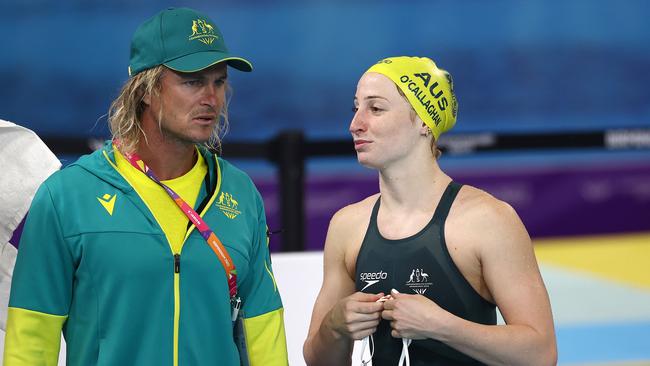
These two competitors will also be in lockstep at the 2024 Australian Swimming Trials in nine days, and, hopefully, at the La Defense Arena pool for this year’s Paris Olympics.
As O’Callaghan turns to race the final leg, all is so far so predictable. Titmus is in the lead. O’Callaghan has swum 150m with restraint and is staying in touch with her competitors via some world-class tumbleturns. She is sitting on the hip of Titmus as the pair go into the final turn, and when O’Callaghan resurfaces she is charging towards Arnie, reeling her in with every stroke. Now we’re 20m from the wall and the commentary from Mat Thompson is utterly breathless: “O’Callaghan is coming at her. The two Australians neck and neck. What an epic race!”
Then a low exhalation from Ian Thorpe: “Ooooh.” The usually even-keeled Thorpe has just signalled to viewers with this out-of-character utterance that something rare is unfolding. Something that experts will analyse in countless replays of the race in the wake of the competition.
Says Thompson: “It’s Ariarne leading but for how much longer? Mollie’s going to her. The world record’s in jeopardy. Mollie O’Callaghan over the top. Come on, Mollie – stretch out!”
Thorpe again: “Yesssss! Amazing!”
O’Callaghan has climbed the mountain. Somehow she’s overcome Titmus. Hit the wall in first place. And broken the world record.
“Under 1:53. Incredible. 1:52:85. Mollie O’Callaghan! Incredible swim! So perfectly timed. Arnie with the PB as well, 1:53:01. They’ve trained together and they’ve won this together – the quinella for Australia,” Thorpe says.
Thompson declares: “A moment we will never forget. Mollie O’Callaghan is the world record holder.”
On top of the podium, the youthful O’Callaghan is all smiles. Just before the anthem starts she gestures to Titmus and waves her up to the top step. The pair stand side-by-side as Advance Australia Fair plays. It’s a touching moment between two fierce rivals. Not until well after the race does Titmus admit: “To be honest, I wanted to win that.”
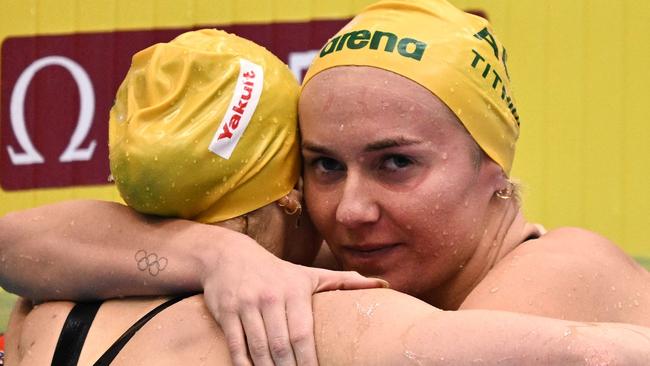
For O’Callaghan, it was the culmination of a spectacular rise since qualifying as the youngest member of the Tokyo Olympic team. And all eyes will be on her to do it again on sport’s biggest stage. There’s no question she has the potential to win gold in Paris.
The key to her success that night were partly those world class underwater turns.
Nick Smith, senior movement scientist at the Queensland Academy of Sport, breaks down O’Callaghan’s technique: “As she comes into the wall, she rotates really quickly so she can get her feet to the wall quite fast after she takes a last stroke, and she’s really powerful [pushing off it] … and then, probably the key part of her turn is her underwater kick speed for such a long period of time – so she makes up a lot of ground in the underwater phase.”
He adds: “She’s got very good legs. She trains a lot on her underwater kick and her kick in general during freestyle and backstroke to be able to use her legs as a strength. So you see her legs are quite high in the water, a lot more splash, particularly when she’s sprinting. Her stroke length is a little bit longer because her kick is so efficient. She’s really flexible which allows her to have more purchase in the water when she does her underwater kick.”
‘FISH OUT OF WATER’
On an overcast March day, as weekend warriors cut up the waters at the heritage-listed Centenary Pool in Spring Hill, Brisbane, The Weekend Australian Magazine has been granted a rare audience with the hottest swimming talent in the world – Mollie O’Callaghan, now 20. She sits in a plastic chair poolside, wearing slides and a tracksuit, and speaks openly and humbly about her rise. Afterwards, she’ll have her hair and make-up done for our cover shoot. She has natural poise, but is not yet a veteran of glamorous photoshoots for queens of the pool, and is bashful at the start – a fish out of water.
We start with that night in Fukuoka, when O’Callaghan touched the wall and surfaced gasping for air. She looked to the results board wide-eyed, with no idea what she’d just done. First realisation: the gold. Then the time: 1:52.85. “Oh sweet, a PB,” she thought. A personal best. She had not realised it was much, much more. “I didn’t know what the world record was,” she says. “And then a few moments later I was like, ‘Wait, is that a world record?’”
In that final lap of that monumental swim, as she mowed Titmus down, O’Callaghan was churning through water faster than the fastest man in the world. She split the final 50m at 28.11 seconds – commentators have pointed out this was quicker than Romanian superstar David Popovici had swum the final 50m of his 200m freestyle final at the same meet.
Popovici was trying out something new, O’Callaghan says, modestly: “He did have a different race plan, you know, like he was testing something out,” she says. “You can’t really compare …” But people do, of course.
She concedes with a grin: “Poor dude.”
“To know my back end [final lap] is on par or close to a man is a bit weird, a bit crazy … [but] it’s what I train for and I do love racing the boys in training …” And she loves beating them.
O’Callaghan trains under top coach Dean Boxall. The mercurial Boxall runs the world renowned St Peters Western Swim Club in Indooroopilly, Brisbane – a hot-house for would-be and actual Olympic and world swimming champions. Readers will remember him for his headline-grabbing hip-thrusting celebration of Titmus’ 400m gold medal at Tokyo – “He looks like Doc Brown,” said one bewildered American commentator, reaching for a comparison with Back to the Future’s wild-haired professor. The St Peters Western squad includes Titmus, O’Callaghan, women’s 100m specialist Shayna Jack and men’s 400m world champion Elijah Winnington.
St Peters Western has a serious reputation for discipline. It is hardcore. Athletes run on a Boxall-prescribed diet of belief and accountability. The coach has said his system is designed to produce dogged athletes. “When I first moved, I was so scared,” O’Callaghan says. “I did not like it … I was only 14 and it was very hard at the beginning”. So, how did Mollie from Logan, who grew up wanting to be a police officer and raced only for the fun of it, end up in the pool of the most intense coach in swimming? How did she get so ferociously fast? So competitive? And so hungry?
She got there after she heard seven words. Seven words from a mother to her daughter: You can potentially do something great here.
“You can potentially do something great here.”
Toni and Nick O’Callaghan are hard-working people. Toni works in the gardening industry while Nick is a construction manager. Initially, the family lived in Logan. Later they moved to Ipswich. O’Callaghan describes her parents as firm but “loose” when needed. She says mum Toni, who first took her swimming, is a “good balance between nurturing and tough”. The youngest of three kids, O’Callaghan naturally tagged along to most things her older sister Sophie did; one of those hobbies was swimming. In the beginning, she says, she just liked to “float” in the pool. Nick has recalled walking alongside the Greenbank State School pool-edge to ensure his daughter didn’t sink in her first race. Once she learned how to swim the length of the pool competitively, she fell in love with racing. Toni says her “funny and goofy” girl was always “observant by nature”. “She puts all the pieces together, and uses it as a strength. She loves a tough challenge that most would shy away from. I would always say this girl would burst a vessel to be the best.”
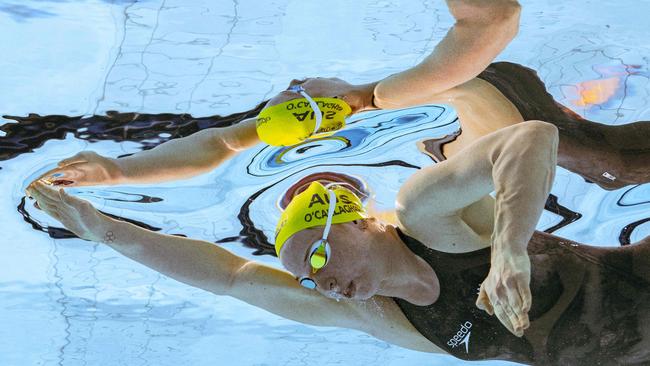
One of O’Callaghan’s best friends, Chelsea Hodges, who retired from swimming last week at just 22, says the “super supportive” family unit is a big part of her success. “She’s the youngest sibling in her family, and like most youngest siblings do, she is always making sure she is seen,” Hodges says.
‘LIKE A DOLPHIN’
By 2014, O’Callaghan, aged 10, was training under Paul “Cowboy” Sansby as part of the Waterworx squad in Springfield, and collecting gold medals for fun. Says Sansby: “She has an outstanding kick – I mean, if you see her walk, she’s not designed to be on land. She’s pigeon-toed, she sort of stumbles along, you wouldn’t want her to run more than 10 feet, she’d fall over and break her neck.
“She’s basically a land-based dolphin. If you watch her work underwater, she actually moves like a dolphin … it makes her super quick underwater. There’s just a few people on the planet who can do that and she’s one of ’em.”
O’Callaghan was a “pretty easygoing kid” who had a bit of “spunk and spirit” about her, says Sansby. At his instruction, she trained ten times a week, swimming between 50-60km. “She was more determined than naturally talented,” he says. At the time, her preferred stroke was backstroke and at 13 she was ranked sixth in the country for the 50m race. He says starting as a devoted backstroker is how she perfected her secret weapon – that superb underwater turn, the envy of every swimmer in the world.
Never mind the backstroke though, what about her performances in the 200m freestyle? Well, those infuriated Sansby. “She used to bludge that 200 free every year,” he says. “She’d sometimes just miss the final – which I thought might be deliberate. It’s a little bit ironic that she broke the world record in the 200 free because the girl can backstroke.”
Back in those days, Toni would spend her time fundraising in the local community to help send her prodigiously talented daughter off to swimming championships interstate, and to buy what Toni recalls as a “$300 proper racing swimsuit”. O’Callaghan explains it was her mum who decided she should move swim squads. “Mum was like, I need people to train and to push me, but also I need [to be] more professional.”
O’Callaghan was 14 when she left Cowboy’s cradle and made her debut as a member of Boxall’s squad. Toni knew St Peters Western was the place to be if you wanted to be something in this sport. Her daughter was apprehensive. “You hear it’s a very hard-working club … and [at first] it put me off because I’m like, ‘Oh my God, this is going to be so scary,” she says.
It was a move to a highly professional, intense environment. Demands at St Peters Western are huge. Workloads are enormous. The military-style “hell month” training bloc is notorious for pushing athletes to their absolute limit. O’Callaghan says it was difficult changing not only her swimming club, but also her school. Her new school was the prestigious St Peters Lutheran College, whose aquatic centre St Peters Western calls home. She was in the pool every morning with older squad members – current Olympians, athletes who ripped and tore into the water and in the gym. A “baptism of fire” she says, but she learned to love it.
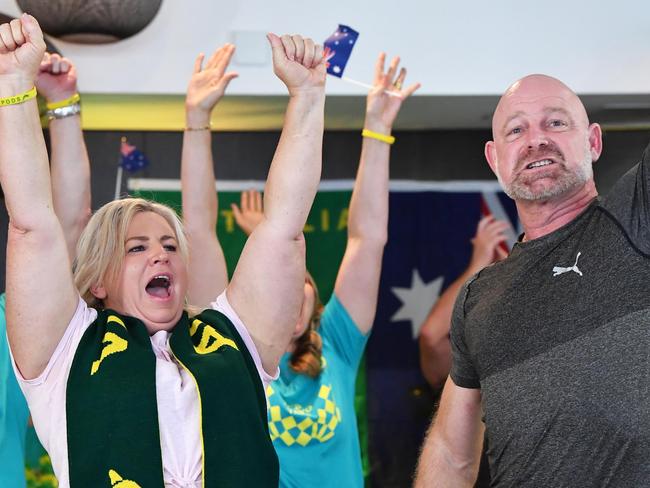
She also didn’t want to waste her mum’s time. At this stage Toni would be up at the crack of dawn, driving for an hour to St Peters Western many mornings a week. O’Callaghan was well aware of her mum taking time out of her day, “waking up early, cooking, cleaning, working, doing everything”, she says. She decided to give it her all as her mum gently willed her to try to reach her potential.
But Toni places the credit firmly with her daughter: “People always say, ‘You must be proud’. I’m proud of so many things about Mollie, [especially] her resilience and her ability to adapt to becoming a professional athlete at a young age”.
Boxall quickly took notice of O’Callaghan’s work ethic, and before long he would predict greatness for her in the pool – albeit not in her favoured events. She had come to the St Peters Western pool with two pet events – the 50m and 100m backstroke. She also liked the 100m freestyle, but the 200m? Her style as a swimmer was to just dive in and “go max”, you see, and the 200m was an “awkward” distance. Boxall would present her with 200m race plans – which she would not embrace.
“I was very stubborn at the start, it was very hard to grasp a strategy,” O’Callaghan says.
“And you’ve got to believe in yourself to do it … and I think I struggled with that at the start, believing, you know, this could work out. Like if I try something new, it could work out but it’s OK to fail. You have got to put yourself in a difficult situation where it’s like, you might not win, but you learned something new.”
By 16, Boxall started telling her she could make the Tokyo Olympics. He said she could be a dark horse. There would be no pressure on her. “Go for it. I believe in you,” he said.
She started to believe it herself because her times in training were getting faster. She could feel the shift. She was now eclipsing swimmers she had once trailed behind. Then she made the Olympics at 17 and was selected as a relay alternate. She went to Tokyo and broke a junior 200m freestyle world record in the relay heats. She helped Australia bring home two Olympic gold medals and a bronze by swimming in those heats of the 4x100m freestyle relay, 4x100m medley relay, and the 4x200m freestyle relay.
Soon after the junior world record swim at the Olympics, Boxall, in a rare podcast interview with former swimmer Brett Hawke, talked up her “magnificent kick” and marvelled at her having “one of the fastest backend speeds in the world”. Then Boxall warned the world. “People around the world better be careful of Mollie because she is dogged,” he said, before turning to speak directly to his young charge: “Believe mate, you’ve got it in ya.”
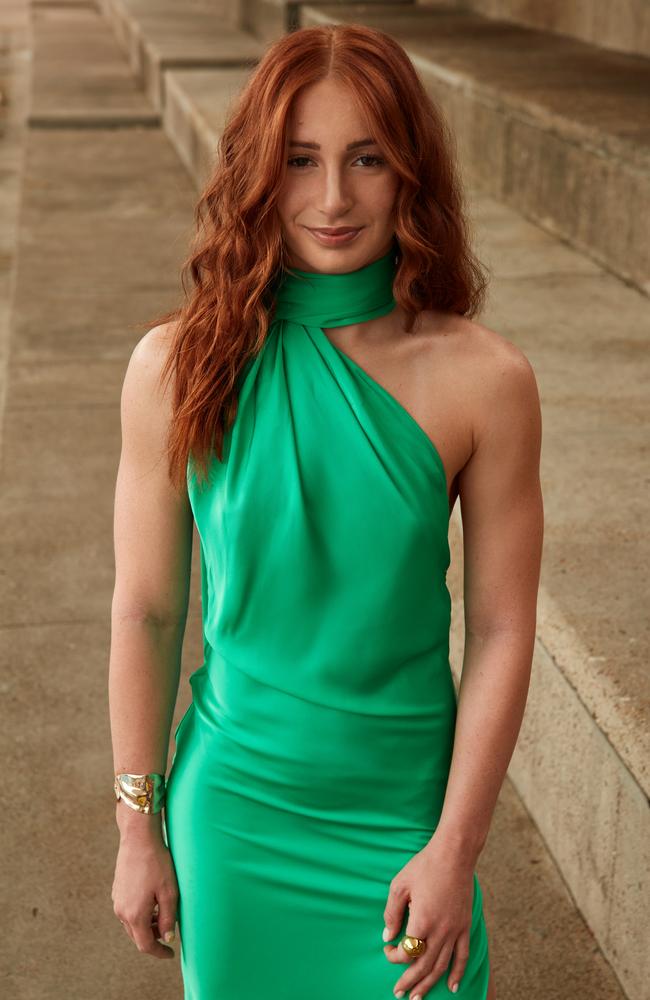
OVERCOMING SELF-DOUBT
At Fukuoka, O’Callaghan believed – showing the world she was a force to be reckoned with. Besides the 200m gold, she also took out the blue ribbon 100m freestyle, and was a key member of Australia’s three world record-breaking relays, leading off in the 4x100m freestyle and 4x200m freestyle, and anchoring the 4x100m mixed freestyle race. It was the meet that cemented her standing in swimming’s top echelon – as one of the best there ever has been in the world.
Looking back, O’Callaghan confesses she didn’t feel like she was “good enough” until she was on her second senior Australian team in 2022. At Tokyo she had swum brilliantly in the heats but hadn’t been selected for the final relay teams — despite her junior record. At the time, Toni’s passion for her daughter’s career was on full display when she publicly questioned the team selectors’ decision to leave O’Callaghan out of the finals.
VIDEO: EXPERT NICK SMITH BREAKS DOWN MOLLIE’S WORLD RECORD SWIM:
“I have a very high expectation of myself,” O’Callaghan says. “Over the years I kind of found I’m more deserving of being a part of the green and gold, on the team, [but] when I made my first senior team [for the Tokyo Olympics] it was kind of at that point I was like, ‘Oh, I’ve got potential, but I’m only on this for a relay’. And it was not an individual [event] and I didn’t make the finals [team].
“I felt like coming home with two gold medals and a bronze, it didn’t feel like it was mine. So when I came back the next year, that’s when I first initially felt like, ‘Oh, I’m actually a part of this … I’m growing and this could be my career’. So over the years, I feel like it’s really built and I felt like I’ve been more deserving.”
She says she still struggles at times with self-belief. “I’ve definitely got a lot of self-doubt … so when it comes to training and racing and all the little things, I have to kind of get reassured by the team around me. So Dean, obviously he is the brains behind it all. I have to go to him to give me advice – am I in a good position at the moment? Is this good enough? Do I need to work on this more? So I think, you know, getting that feedback really gives me more confidence and having everyone around me helping with all the little things – that just makes it stronger and you know, my belief in what I can do. It just gains a little bit more power in that way.”
‘MOCK’ OLYMPICS
Boom. Boom. Boom. Boom. The music is pumping on the pool deck and Libby Trickett is seriously amped at St Peters Western’s Mock Olympics. “I was about to go and flip some tables, I was ready to make my comeback,” she recalls. Last month, Boxall invited Trickett, 39, along to the event, and she sat in the stands flanked by two of her four children, as well as O’Neill and 1988 Olympic gold medallist Duncan Armstrong. Trickett watches members of Boxall’s squad race and train in conditions as close to those that will greet his swimmers at La Defense Arena pool in Paris next month. There is a marshalling area, warm-down rooms, mock races and just like there will be in Paris, a crowd, and legends in the stands. Boxall has brought in an Eiffel Tower with a bell under it. He allows swimmers to triumphantly ring it if they hit a specific time he has set for them.
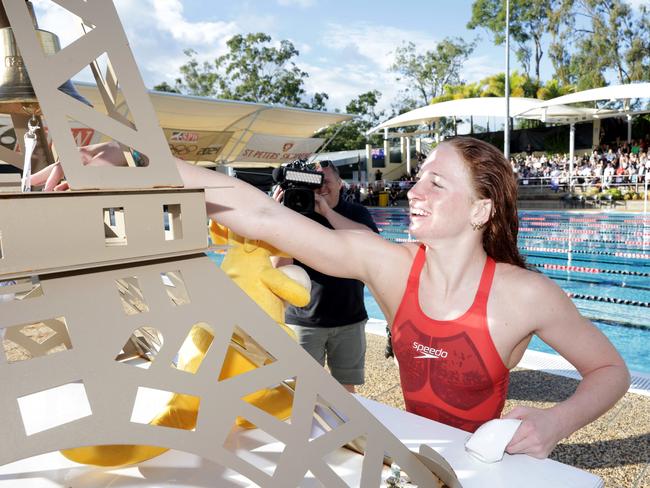
On the pool deck Trickett sees Boxall in full flight, pumping up his swimmers, yelling from the pool deck: “If you want it, you have to go after it now!” It stirs the old competitor in Trickett – she can see why the likes of O’Callaghan respond to him. Her swimmer’s eye catches O’Callaghan methodically racing and training, and she can see this is an athlete who appreciates “the grind” of it all.
“It can be a lot of pressure going into an Olympic year, being a world record holder and world champion at 20,” Trickett says. “She’s still so young but she does have a significant amount of experience already under her belt and I think she does have her head screwed on, and that’s to do with Dean. I think the way he prepares his athletes is awesome. He’s not going to be everyone’s cup of tea – I get it. But I think he’s incredibly inspiring and motivating for his athletes, and it works for them.”
O’Callaghan has nothing but plaudits for Boxall. He has a “reaffirming” way of coaching, she says, of making you believe you are going in the right direction. “He’s very concerned about each of his swimmers, it’s kind of like we are his children, in a way. He takes a lot of time for us and his whole life revolves around swimming. His goals are our goals. How we perform reflects on his training and who he is as a coach.”
She adds: “He has his crazy side but I rely on him quite a bit and I know all of us should give him a break from time to time … but it’s a bit hard in this [Olympic] period. We’re constantly annoying him. ‘Dean … Dean …’ But he’s always there for us no matter if it’s on the weekends or in training. He’s always checking up on us and he knows exactly what to do. It’s amazing to have a coach like that and that’s why he has the world’s best swimmers. I would say he is the world’s best coach.”
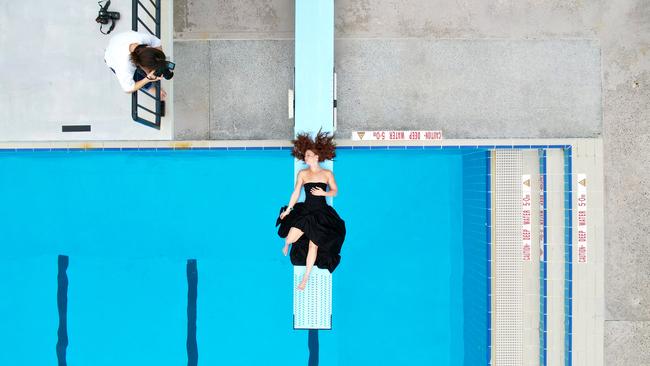
‘PERFECT’ RIVALS
Two titans of the sport. One another’s biggest rival. It is certainly impressive that Dean Boxall’s squad somehow has enough room in it to fit O’Callaghan and Titmus. They swim together, side by side, daily. James Magnussen, for one, can’t wrap his head around it. “I don’t know how he does that … and I don’t know how they do it,” he says. “It’s testament to them that they can keep egos and personalities out of it and just get about their work seemingly without any issues.”
O’Callaghan says Boxall knows when to push them in training, and when not to. “I’ve got a lot of people in my squad who are competing against me,” she says. “But [for Titmus and I], I think Dean has worked out the way to perfectly balance when we should compete against each other and when we shouldn’t. We have our moments together and we have our moments apart. When it comes to a competition, you never know what the other girls are doing but at the same time [you take comfort that you’ve] pushed yourself against the greatest women Australia has ever seen.”
In an interview several years ago, Boxall put it more succinctly: “You just don’t get them to go against each other all the time, you pick your fights”.
Of course, O’Callaghan can also see the upside of having fierce competition in training – it could mean more medals as a team in Paris. “In the end, [it] involves us as a 4x200 team, or a 4x100 team, and I think that’s perfect.”
“Everything just comes into place and it aligns so perfectly. You hop in the water and you’re just so free.”
Nine days from now these two great rivals will take to the Brisbane Aquatic Centre pool for the 2024 Australian Swimming Trials. It is the only qualifying competition for the Olympic team and O’Callaghan will contest the 100m and 200m freestyle – the jury’s still out about whether she’ll contest the backstroke. Swimmers must finish in the top two places to make the team. It’s a dog-eat-dog competition. Miss the places, miss the Olympics.
Typically, when O’Callaghan takes the blocks she is nervous. She fiddles with her goggles, she thinks she will vomit. “You’re thinking the worst things possible, the adrenaline is going, you’re on edge,” she says. And yet, she steadies at exactly the right moment. Once she hits the water, she says, all she feels is “flow”. It feels amazing. “Everything just comes into place and it aligns so perfectly. You hop in the water and you’re just so free and – obviously, you’re determined and you want to do this or want to do that – but everything just comes so naturally.”
Trickett, the world-record-breaking, gold-medal-winning swim star, describes O’Callaghan’s starts, finishes and turns as “sublime”, adding: “She just absolutely flies underwater.” Trickett also loves the way she goes about being a swimming superstar. “She’s doing it all in a low-key way. She has a chilled-out vibe … she’s not telling everyone she is the greatest or going to be the greatest.”
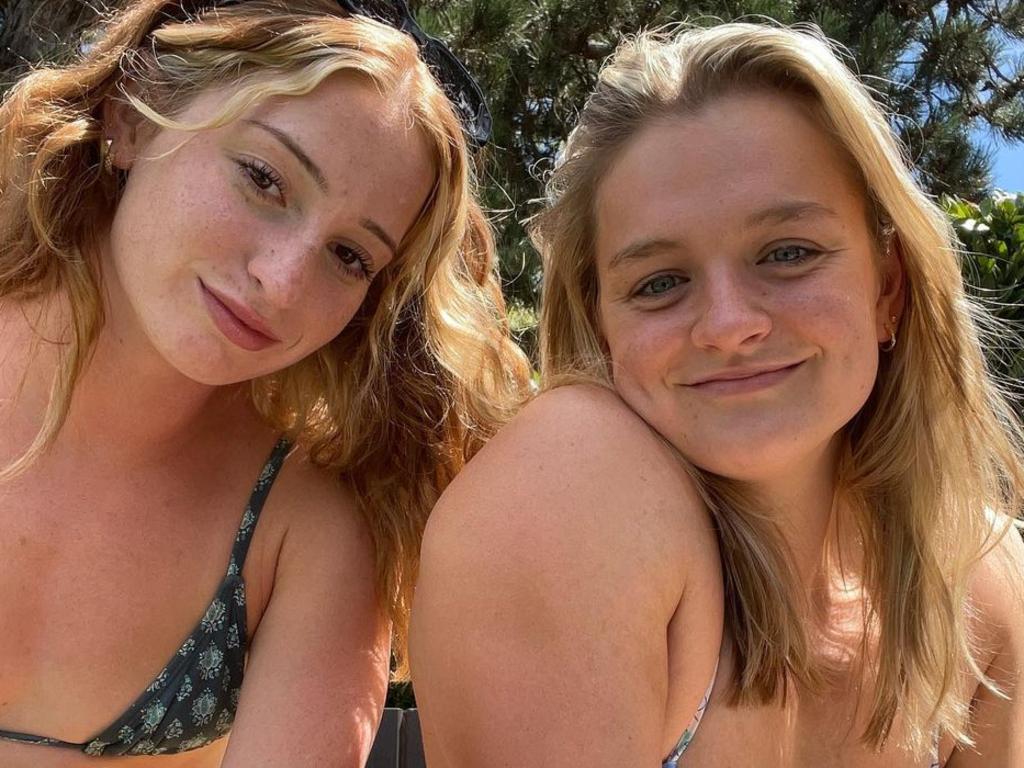
Hodges, describes her best mate as “the most chill person, who never takes herself seriously and makes the most fun of any situation”. She recalls how one day after training, the pair had the afternoon off so they hit the Gold Coast to get matching cherry tattoos. To this she adds that O’Callaghan is intensely “loyal ” and “uniquely herself”. “She never changes herself for anyone or anything … she’s the best person to have as a best friend,” Hodges says. “That girl would go to battle with everyone for you.”
All going well at this month’s trials, O’Callaghan will be in a battle for gold medals in Paris. Her Olympic program includes a likely six events – the 100m and 200m freestyle and four relays. Says Magnussen: “She can become our greatest Olympian ever. If I was a betting man, I’d be backing her for five gold medals at the Paris Olympics.”
Says O’Callaghan: “Obviously, everyone would love to win an individual gold – that’s what we’re all striving for – but I think also I’m going to be happy with just making the team.” Yes, first, she’s got to get through those trials. Shayna Jack will be there, pushing her all the way in the 100m. Ariarne Titmus will be there, pushing her all the way in the 200m. And Dean Boxall will be there too, pacing the pool deck, offering his go-to words of encouragement, what O’Callaghan calls his “small affirmations”. Something like, “Good job, Mol-doggy. That was really good.”

Add your comment to this story
To join the conversation, please log in. Don't have an account? Register
Join the conversation, you are commenting as Logout
The Israeli underground carpark transformed into a 2000-bed hospital | WATCH
WATCH | Deep beneath a medical centre in Israel’s north, babies are being born in a carpark converted into an extraordinary world-class hospital that is running like clockwork as bombs and rockets rain down above.
‘Corporate bastardry’: Betrayed players turn on AFL
The sport’s governing body has been accused of deliberately ignoring evidence of catastrophic brain injuries in a bid to avoid liability for up to $2.5 billion in legal claims.